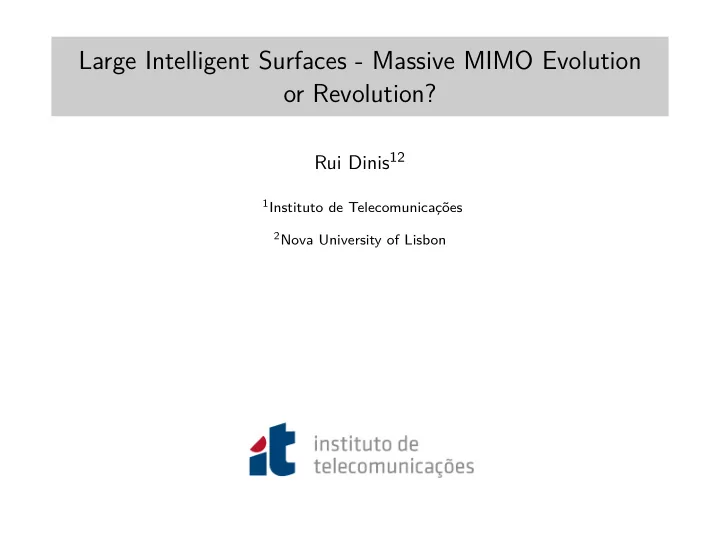

Large Intelligent Surfaces - Massive MIMO Evolution or Revolution? Rui Dinis 12 1 Instituto de Telecomunicac ¸˜ oes 2 Nova University of Lisbon
Outline 1 Motivation 2 MIMO 3 Massive MIMO 4 LIS Concept Challenges 5 Conclusions Lisbon, Nov. 25, 2019 2/15
Digital Communications • Low error rates • Higher and higher bit rates • Spectral efficiency [bps/Hz] • Power savings Lisbon, Nov. 25, 2019 3/15
Channel Capacity C = B log 2 (1 + SNR ) • Channel coding • Turbo codes • LDPC codes • Polar codes • Equalization • MLSE • OFDM • SC-FDE • Synchronization and channel estimation Lisbon, Nov. 25, 2019 4/15
MIMO Channel I + SNR � � �� HH H C = log 2 det N Tx • Channel capacity grows with the number of antennas • Gain relatively the SISO case upperbounded by min( N Tx , N Rx ) • Suitable for OFDM and SC-FDE schemes • Optimum receiver too complex • Practical receivers based on MMSE with excellent performance/complexity trade-offs Lisbon, Nov. 25, 2019 5/15
Massive MIMO • Conventional MIMO schemes suitable for systems up to about 8 × 8 • Massive MIMO not a scaled version of MIMO! • Low complexity implementations (low resolution DACs and ADCs, strongly nonlinear amplifiers, simplified equalization/pre-coding, etc.) • Common elements (RF chains, mixers, DAC/ADC, etc.) • Channel estimation challenges (e.g., pilot contamination) Lisbon, Nov. 25, 2019 6/15
LIS - Large Intelligent Surfaces • Evolution of massive MIMO • Much more antenna elements • Short range • Near field communication • LoS communication Lisbon, Nov. 25, 2019 7/15
LIS Access • Antennas switched on and off according to user position and/or user requirements • Resource allocation at the space domain Lisbon, Nov. 25, 2019 8/15
LIS for Positioning • Antennas with different RSS and/or AoA/AoD • Accurate positioning Lisbon, Nov. 25, 2019 9/15
LIS for Communication • Communication aided by positioning information • Low complexity transmission and detection schemes • Huge capacity and coverage gains • Robustness to interference and imperfections Lisbon, Nov. 25, 2019 10/15
LIS for Energy Harvesting • Beamforming to compensate losses in energy harvesting • Better range and/or energy harvesting efficiency than traditional techniques • Ranges of 1m or more Lisbon, Nov. 25, 2019 11/15
Transceiver Design • Need for very low complexity transceivers • On/off approaches • Beamforming • Skip equalizers? • Interference cancellation • Low resolution DAC/ADC (1 bit quantizers?) • Low complexity amplifiers (saturated or even switched amplifiers) Lisbon, Nov. 25, 2019 12/15
Channel Estimation • Too many channel to estimate • Parameterized channel models • Position-aided channel estimation • Channel tracking Lisbon, Nov. 25, 2019 13/15
Resource Allocation • Space-domain resource allocation • Aided by position information • LIS split in panels • Many antennas per panel • Small number of outputs per panel • A user can be associated to several panels Lisbon, Nov. 25, 2019 14/15
Conclusions • Path from SISO to LIS • LIS with very high potential • Challenges • It is possible! Lisbon, Nov. 25, 2019 15/15
Recommend
More recommend